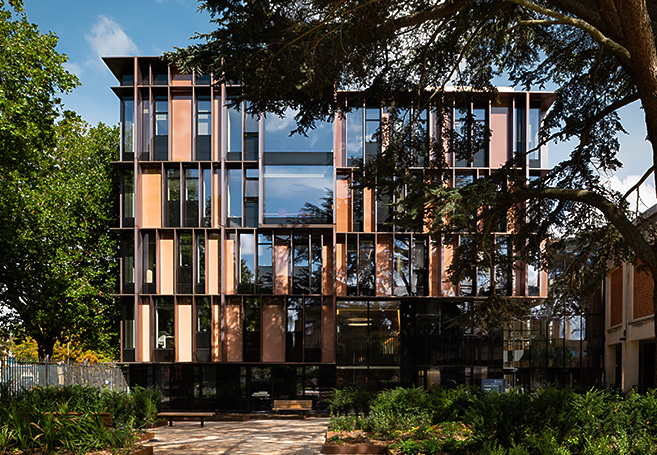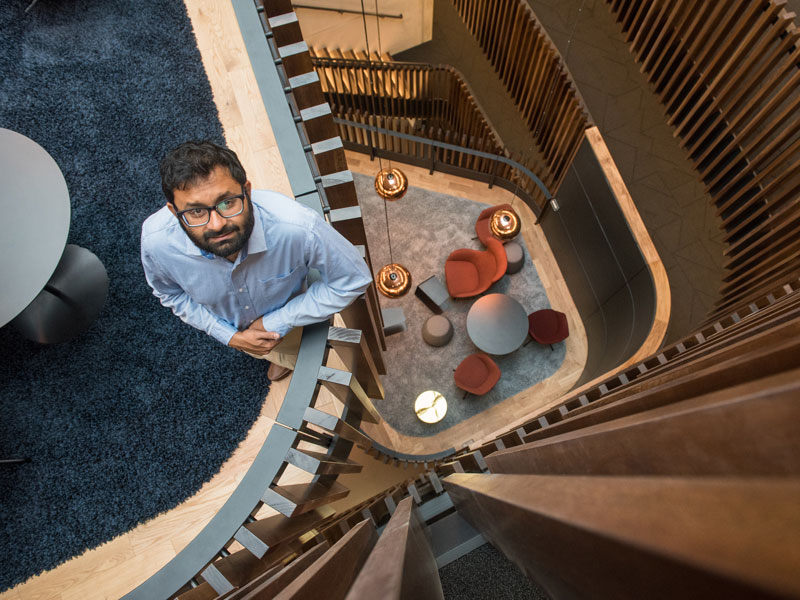The new Beecroft Building will enable quantum theoretical and experimental synergies to flourish at Oxford.
The world of quantum physics, with its long time frames and as-yet unknown outcomes for our future, is not always suited to applications-focused funding. What is vital, says Siddharth Parameswaran, Associate Professor of Quantum Condensed Matter Theory, is core funding for basic physics, allowing scientists the freedom to follow where their research leads.
Oxford, along with its donors, has the confidence to follow exactly that approach – a stance that brought Professor Parameswaran from the University of California, Irvine, to join Oxford's Rudolf Peierls Centre for Theoretical Physics in 2017. That confidence is evidenced by the new £50 million Beecroft Building, the University's first construction in 50 years to be dedicated to the theory and practice of physics.

Designed by architects Hawkins\Brown, the facility is named in recognition of the major support kindly donated by Adrian and Jacqui Beecroft. Within it is the Wolfson Centre for Quantum Science and Technology, funded by the Wolfson Foundation.
The building includes offices for theoretical physicists such as Professor Parameswaran, as well as state-of-the-art basement laboratories. Professor Parameswaran explains: 'Physics needs extremely complex equipment – vibration isolation, optical tables that float on air – and there's often a bottom-line-driven attitude that is more concerned with return on investment than on asking scientifically interesting questions. But you can't put a price on the pure science. You need to think about those questions in order to understand a mechanism that you can then, if you understand it well enough, translate into something that sits on your table top.' The smartphone would not have been possible without the study of quantum physics.
The Beecroft Building is designed to facilitate interaction. It links on three levels to the 1939 Lindemann Building at the Clarendon Laboratory complex, and its central atrium is an airy hierarchy of spaces to suit discussion groups of different sizes. These range from small areas where a few people can gather around a curved, double-height blackboard (theoretical physicists favour real blackboards, with real chalk) to giant 'steps' that can be used as lecture seating. The atrium can also double as an exhibition space for public events, while at the bottom is a communal coffee area that everyone passes on their way into the heart of the building.
As a theorist, a collaborative environment allows me to work on whatever I want to. That was one of my major reasons for coming to Oxford, because I felt that if I wanted to go in a new direction, there would be other people with the courage to go in new directions with me.Professor Siddharth Parameswaran
This carefully judged layout puts Professor Parameswaran within easy reach of other groups with a similar focus. He points out: 'At Oxford there are around 20 different groups doing diverse experiments in condensed matter physics. My colleagues come over for coffee and we spark up conversations.'
Professor Parameswaran comments: 'The strength of my sub-field of physics is that there are a lot of different experiments going on.' He is very interested in collaborating with experimentalists; their input stimulates his research in turn and he is currently working on a series of joint experiment and theory papers.
'In the condensed matter group', he explains, 'everything is driven by trying to understand what happens in the setting of many particles moving in very complicated environments. My work focuses on quantum mechanical systems of many particles that are strongly interacting, far from equilibrium, or both.

'One of the things we are trying to do is build a theory or framework for handling far-from-equilibrium quantum phenomena. There's a lot of interest in how that connects to the ideas of quantum entanglement and quantum chaos – about how quantum systems really transfer information. I would like a better understanding of that, and to develop some better tools.'
Oxford is now the UK's largest and most diverse centre for quantum research, with over 200 researchers in 38 separate teams. This includes the Networked Quantum Information Technologies Hub, part of the government's £270 million investment to establish a quantum technology industry in the UK.
Amid the excitement about possible new applications, Oxford understands that funding pure science is the key to new advances. This was echoed by the alumni and friends who made such generous donations to this project.